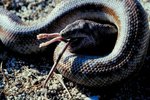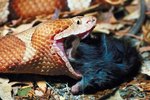
Though they make many people uncomfortable or nervous, spiders and snakes are incredibly important predators that keep ecosystems in balance. While the vast majority of snakes and spiders in West Virginia are harmless, one species of spider and two species of snake are capable of causing medically significant symptoms.
Copperheads
Copperheads (Agkistrodon contortrix) are the most commonly seen venomous snake in West Virginia. Colored to match the dead leaves on the forest floor, copperheads blend in masterfully with their habitat. While adults are ambush hunters of rodents, frogs and birds, juveniles consume frogs, insects and lizards. Copperheads are relatively small snakes that rarely exceed 42 inches in length when full grown. Due to both their small size, and relatively weak venom, copperhead bites are rarely fatal.
Timber Rattlesnakes
Timber rattlesnakes (Crotalus horridus) are one of the largest snakes in West Virginia. Averaging 4 to 5 feet in length, timber rattlesnakes prey on squirrels, rabbits, birds and rats. They use their namesake rattle to dissuade predators, though they don’t always shake their rattle before biting in defense. Timber rattlesnakes prefer forested uplands, and -- unlike the copperhead that thrives around human habitation -- timber rattlesnakes tend to avoid areas frequented by humans. Timber rattlesnakes have a much higher venom yield, larger fangs and more potent venom than the copperhead; bites can be very serious or even fatal.
Harmless Snakes
Aside from copperheads and timber rattlesnakes, the remaining 20 snake species native to West Virginia are harmless to humans. Though the ringneck (Diadophis punctatus) and hognose (Heterodon platirinos) snakes are equipped with venom, bites and serious symptoms are very rare. Black rat snakes (Pantherophis obselota), black racers (Coluber constrictor), northern water snakes (Nerodia sipedon) and garter snakes (Thamnophis sirtalis) are frequently encountered species. Additionally, locals often find small, subterranean species such as smooth earth (Virginia valeriae), red-bellied (Storeria occipitomaculata) and brown (Storeria dekayi) snakes under rocks, logs and other debris.
Black Widows
While the vast majority of spiders are venomous, most are not dangerous to humans. However, black widows (Lactrodectus mactans) produce very virulent venom, and are the only dangerously venomous species in West Virginia. Identify black widows by their jet-black bodies, which contrast strikingly with the red hourglass marking on the ventral surface of their abdomen. Some black widows also have red markings on the dorsal surface of their abdomen. These spiders are important predators of insects, and often hang upside down from their webs waiting for food to land there. Black widows frequent old sheds, wood piles and rock piles.
Harmless Spiders
Virginia is home to dozens, if not hundreds, or spider species. Many of the orb weavers (Family Araneidae) spin webs between trees in order to catch flying insects. Meanwhile, crab (Family Thomisidae), wolf (Family Lycosidae) and jumping (Family Salticidae) spiders prowl for prey on the ground and in the trees. Most spiders are shy and do not seek out interactions with large predators such as humans. In the rare instances that these spiders bite, the symptoms are usually no worse than a bee sting.
References
- Marshall University: Snakes of West Virginia
- West Virginia Department of Natural Resources: Snakes of West Virginia
- West Virginia Department of Agriculture: Spiders in West Virginia
- Animal Diversity Web: Agkistrodon Contortrix
- Animal Diversity Web: Latrodectus Mactans
- Savannah River Ecology Laboratory: Canebrake / Timber Rattlesnake
Photo Credits
-
Jupiterimages/Photos.com/Getty Images



